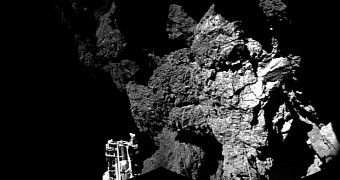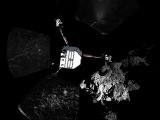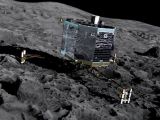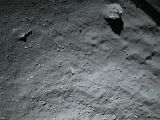Unless you live under a rock in the middle of nowhere and that rock is humanity-proof, you probably know that, earlier this week, the European Space Agency's Philae lander successfully made it on the surface of Comet 67P/Churyumov-Gerasimenko.
The lander, together with the Rosetta spacecraft that carried it all the way to its target comet, left Earth about 10 years ago, on March 2, 2004. The two spacecraft and the celestial body are now heading for the Sun at a speed of about 18 kilometers (11 miles) per second.
The Philae spacecraft landed on Comet 67P/Churyumov-Gerasimenko this past November 12. Just hours later, it sent several photos of its news home back to Earth. Of these photos, one shows one of the lander's feet resting on the surface of the comet.
Philae outdid itself this past Friday
As if having a spacecraft snap photos of the surface of a celestial body 511 million kilometers (317 million miles) away while holding tight to its body weren't a good enough reason to awe and wonder, recent news says that, this past Friday, the lander managed to drill into the comet.
“I confirm that my @RosettaSD2 went all the way DOWN and UP again!! First comet drilling is a fact! :)” reads a European Space Agency Twitter post that made it online less than 10 hours ago.
It is understood that, while drilling into the comet looking to obtain samples that might shed new light on the makeup of this celestial body, the lander managed to also rotate its body ever so slightly. This could help it get the sunlight it needs to keep up and running.
“I just started lifting myself up a little and will now rotate to try and optimize the solar power!” reads a Philae lander message on Twitter. “Landing gear on @Philae2014 lifted 4 cm [1.6 inches] & main body rotation complete,” another one details.
The lander is now asleep
Shortly after drilling into Comet Comet 67P/Churyumov-Gerasimenko, the European Space Agency's spacecraft ran out of power. Consequently, it shut down its instruments and most of the systems on board, and entered into hibernation mode.
The really good news is that, before falling asleep, the Philae lander somehow managed to transmit all the data that it collected while operational. The data is now being processed by scientists.
As detailed by the European Space Agency, the spacecraft is to remain in hibernation until enough sunlight to power its secondary rechargeable battery reaches it. Hopefully, it will not be long until scientists reestablish contact with the lander.
Despite the fact that the lander only remained operational for a few days, researchers are quite proud of its achievements. As Lander Manager Stephan Ulamec put it, “This machine performed magnificently under tough conditions, and we can be fully proud of the incredible scientific success Philae has delivered.”
Word has it that later today the Rosetta spacecraft will attempt to once again communicate with the Philae lander. Should it succeed, this could mean that that the lander now sits in a place where access to sunlight is not an issue. If this is indeed the case, the lander could remain operational until March 2015.

 14 DAY TRIAL //
14 DAY TRIAL // 



